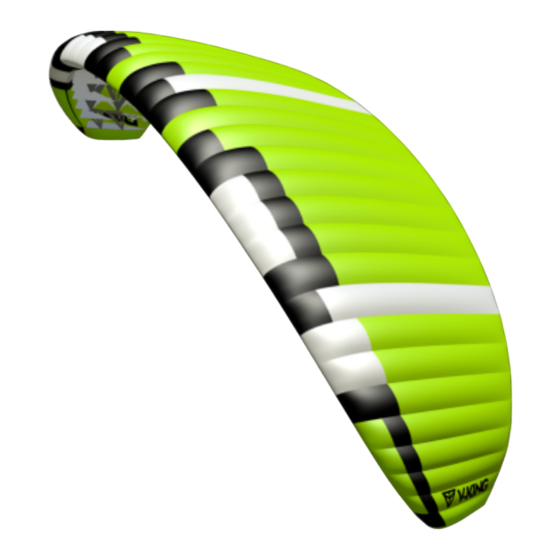
Table of Contents
Advertisement
Quick Links
Advertisement
Table of Contents

Summarization of Contents
On the Wing
For Whom is the V-King Intended?
Defines the intended use and target audience for the V-King paraglider.
Riser Scheme
DBS (D Brake System)
Description of the D Brake System for improved flare and landing.
ELR (Easy Launch Riser)
Explanation of the Easy Launch Riser system for easier takeoff.
Speed System Features
Overview of the speed system affecting A, B, and C risers for increased speed.
Before First Use
Operation and Weight Range
Pilot responsibility for canopy choice and understanding weight limitations.
Harness and Speed System
Choosing a certified harness and understanding speed system functionality.
Before First Use
Speed System Adjustment and Other Systems
Instructions for adjusting the speed system and information on other available systems.
Pre-Flight Check
General Pre-Flight Checks
Essential checks of canopy, lines, risers, and brake system before flight.
Classic (Forward) Launch
Step-by-step guide for performing a classic forward launch in light wind conditions.
Free Flying - Launch
Forward Launch
Detailed steps for a successful forward launch, including brake usage.
Reverse Launch
Instructions for performing a reverse launch, suitable for more confident pilots.
Free Flying - Flight
Turning
Methods for turning, combining weight shift and brake input for efficient control.
Thermalling and Soaring
Guidance on thermal flying and soaring techniques, including safety in turbulent conditions.
Free Flying - Landing
Flying with Speed-System
Using the speed system for acceleration and its implications on stability.
Landing
Steps for a safe and soft landing, including flare technique and approach.
Winching
Winching Operations
Procedures and safety requirements for launching and flying using a winch.
Tandem Flying
Information regarding the certification status for tandem flying.
Powered Flights - Launch
Pre-Launch Checks and Canopy Preparation
Essential checks and canopy layout for powered launches.
Classic Launch with No Wind
Detailed steps for a classic powered launch, emphasizing headwind conditions.
Powered Flights - Launch
Reverse Launch in Strong Wind
Technique for reverse launching with a paramotor in stronger wind conditions.
Powered Flights - Climbing
Climbing
How to climb effectively after takeoff, avoiding steep climbs and engine failure risks.
Powered Flights - Flight
Power-Unit Induced Oscillations
Causes and avoidance of oscillations from engine and propeller configuration.
Level Flight and Fuel Economy
Tips for efficient level flight, using instruments, and optimizing fuel consumption.
Powered Flights - Landing
Power Off Landing
Procedure for landing without engine power, emphasizing precision.
Powered Landing
Method for landing with engine idling, allowing for repeated approaches.
Speed Modes
Neutral Position
Description of the neutral position for minimal speed and sink.
Full Speed
Explanation of the full speed mode for increased speed and sink.
Quick Descent Methods
Wing Over Maneuver
Information on performing 'Wing Over' maneuvers, noting V-King's auto-stabilization.
Aerobatics and Safety
Statement that V-King is not designed for aerobatics and safety precautions.
Extreme Manoeuvres
One Sided Collapse
Handling and recovery from one-sided collapses in strong turbulence.
Frontal Collapse
Understanding and recovering from frontal collapses in turbulence.
Full Stall and Negative Spin
Information on full stalls and negative spins, noting they are rare and to be avoided.
Extreme Manoeuvres
Deep Stall and Emergency Steering
How to manage deep stalls and use emergency steering with D-risers.
Line Over and Cravatte
Dealing with line tangles like 'line over' and 'cravatte', and when to use the rescue chute.
Cleaning and Storage
Folding the Canopy
Follow basic rules for packing the paraglider to retain its special traits.
Cleaning
How to clean the paraglider using water and a soft sponge, avoiding chemicals.
Deterioration - A Few Tips
Repairs
Guidelines for paraglider repairs, emphasizing authorized service.
Inspections
Recommendations for paraglider inspection frequency and authorized personnel.
Environmental Care
Environmental Awareness
Principles for responsible paragliding to preserve the environment.
Recycling of Used Gear
Information on proper disposal and recycling of worn-out paragliders.




Need help?
Do you have a question about the V-KING 23 and is the answer not in the manual?
Questions and answers